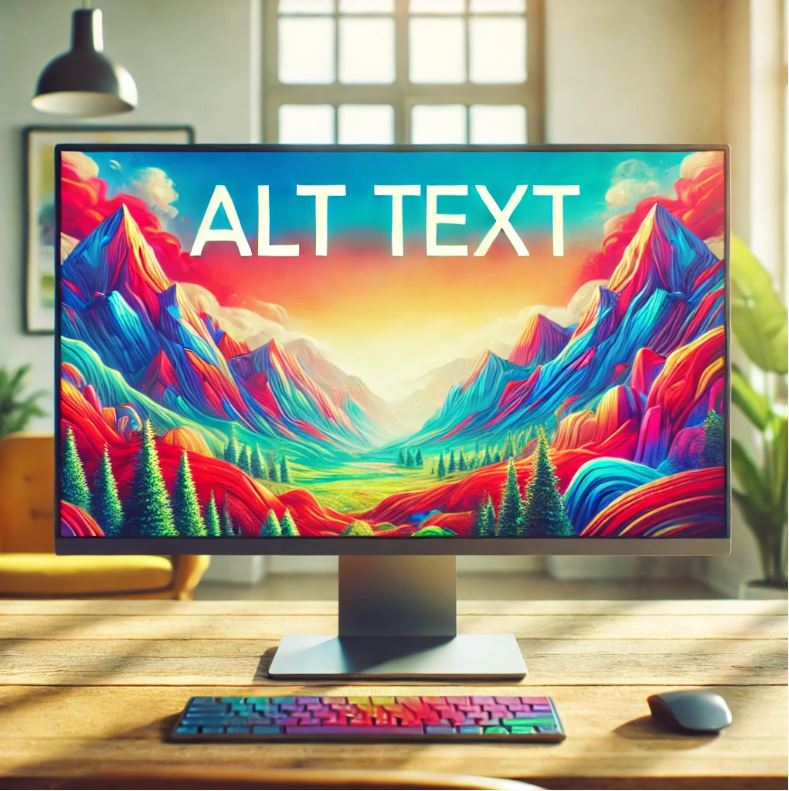 What is Alt Text and How Does it Differ From Other Image Captions?
What is Alt Text and How Does it Differ From Other Image Captions?
What is it?
Alt text, short for alternative text, is like a secret language for images on the internet.
It describes what’s in an image so that everyone, including people using screen readers, can understand what the image shows.
You might find it tucked away in an image tag in HTML code (don’t worry too much about that) but it plays an important role, beyond just digital aesthetics.
What is an Example of Alt Text?
Imagine a picture of a golden retriever puppy playing in a garden. A good alt text might be ‘Golden retriever puppy playing in a sunny garden.’ It tells you what’s happening in a few simple words, easy for both humans and machines to understand.
Why is it Important?
It is important for a couple of main reasons.
Firstly, it’s a must for web accessibility. People using screen readers rely on them to know what’s in images. It is especially vital for those who are visually impaired.
However, there’s more!
It’s also pretty handy for search engines. It helps them understand and index images correctly, which can give your website’s SEO a nice little nudge. So, don’t ignore this when creating content for your website.
What is the Difference Between Alt Text and Caption Text?
The key difference between the two is visibility.
Caption text is visible to everyone when they look at a page, while alt text works behind the scenes, hidden unless you’re using a screen reader or peeking into the image code. It might be invisible but it should not be overlooked.
How Do I Know if an Image Has Alt Text?
Do you have an image and not sure if it has alt text?
You can inspect the element in your browser by right clicking on the image and checking the alt attribute in the code. If there’s a description there, yes, you’ve got alt text. If not, it’s a chance to add some!
Alt text isn’t just a checkbox for accessibility, it’s a bridge to ensure everyone can enjoy and understand your content.
My advice is to create a habit when creating content and adding images. Enter the alt text att hat stage and move on.
How Alt Text Enhances Accessibility and User Experience
Visually Impaired Users
Alt text is a game changer for web accessibility. It helps people with visual impairments use screen readers to experience and understand web content.
Think of it as a translator for images, providing descriptions so everyone knows what’s on the screen, even if they can’t see it clearly.
Not Just Accessibility but User Experience too
It’s not just about accessibility. Alt text also supercharges user experience.
Imagine visiting a site where all images have clear, concise descriptions, suddenly, it just makes sense. Users find it engaging and straightforward, making navigation smoother.
Screen Readers
Screen readers are the main tech tool being used in this space. They read out image descriptions, allowing visually impaired users to visualise what’s displayed.
With alt text, users get a complete image of the content, similar to how they enjoy text descriptions.
Proof?
You might ask if there’s any proof for this. Research and feedback from users with disabilities confirm that sites with comprehensive alt text offer much better usability. Not only does it make content accessible, but it also boosts user satisfaction, which is key to keeping audiences engaged.
To check if an image has alt text, you can use accessibility tools and browser extensions. Just hover or activate the tool to see if alt text is provided. If it’s missing, there’s a real chance to improve your site, for everyone.
Creating Effective Alt Text: Best Practices and Tips
What Makes a Good Alt Text Example?
Crafting good alt text is an art and a necessity.
It involves striking a perfect balance between being descriptive and concise. When writing alt text, focus on capturing the essence of the image in just a few words.
It’s like writing a tweet aiming to provide the full picture quickly, something recognisable and helpful.
Avoid Redundant Dialogue
One key point is to avoid redundancy. Don’t repeat phrases that are obvious from the context, such as mentioning ‘image of’ or ‘photo of,’ because screen readers already know it’s an image.
When to NOT Use Alt Text
Leave out decorative images. If an image serves no meaningful purpose, do not bother with alt text. This way, screen readers can skip over them, letting users move seamlessly through your content without unnecessary interruptions.
Checking
Websites like WAVE or accessibility features in web development tools can highlight images lacking alt text and suggest improvements.
Don’t Forget About SEO – Very Important
Alt text isn’t just an accessibility tool, it’s also about SEO.
Descriptive, relevant alt text helps search engines understand your content better. So, when embedding alt text, use natural language and keep keywords in mind without stuffing them.
It’s a neat trick that helps make your content visible to everyone, including search engine bots.
Remember, there’s a difference between images meant for decoration and those bearing vital information.
Informative images need attention to detail to provide descriptive alt text, while decorative ones can be left without any text, depending on their role in your layout.
